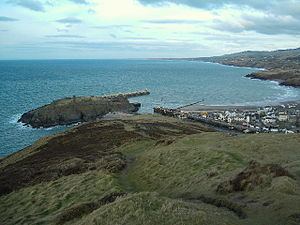Max length 326 m | ||
 | ||
St Patrick's Isle (Manx: Ellan Noo Perick) is a small island off the Isle of Man in the Irish Sea, largely occupied by Peel Castle and noted for its attractive and relatively well preserved historic castle ruins.
Contents
Map of St Patrick's Isle, Isle of Man
HistoryEdit
Archeological studies have shown permanent occupation on St Patrick's Isle dating to the Late Bronze Age. The ruins on St Patrick's Isle include St Patrick's Church and an Irish-style round tower, St German's Cathedral, and the more recent residence of Lords of Mann. The ancient cathedral was left to decay in the 18th century, never to be rebuilt. The island's steep and rocky edges made it an ideal defensive outpost. It is said to be the place where St Patrick first set foot in the Isle of Man in 444 while returning from Liverpool to Ireland. Having established Christianity, he then appointed Germanus bishop, to oversee further development of the Church. However, there is debate as to whether the name "St Patrick's Isle" pre-dates the thirteenth century.
The islet is now a tourist site within the castle walls. There is a public walk around the outside of the castle, which lines the coastal edge of the islet. It is connected to the town of Peel on the Isle of Man by a causeway over Fenella Beach, named after the character in Sir Walter Scott's Peveril of the Peak. In addition to the historic ruins, the island is partially a sealife sanctuary.
St. Patrick's Isle was originally referred to as Inis (or Ynnys) Patraic in Manx.
